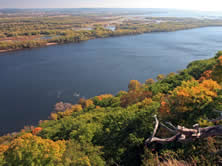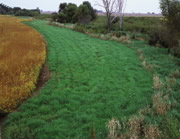Principal Investigator: Stephanie Johnson
Co-Investigator(s): Mark Deutschman and Jan Voit
Organization(s): Houston Engineering Inc.
Local Project Partner: Heron Lake Watershed District
Award Amount: $102,466
Start Date: 3/1/2011 | End Date: 9/30/2012
Project Manager(s): Adam Birr
Goal of the project
The goal of this project was to develop a comprehensive database of information related to agricultural BMPs and provide that information in easily accessible formats to stakeholders across the state of Minnesota.
Background Information
The federal Clean Water Act requires states to adopt water quality standards to protect waterbodies (lakes, rivers, and streams). These standards define how much of a pollutant can be in the water and still allow it to meet designated uses such as for drinking water, fishing and swimming. If a waterbody does not meet water quality standards it is listed as impaired and placed on the Environmental Protection Agency's List of Impaired Waters (303(d) list).
Minnesota has 1,774 waterbodies listed on its 2010 303(d) list. Many of these impairments are due to elevated nutrient levels, high turbidity values and elevated bacteria counts. These pollutants come from multiple sources and fluctuate at different times of the year.
- Nutrients: Phosphorus and Nitrogen
- Bacteria: E. coli and Fecal Coliform
- Turbidity: A measure of water clarity that is related to the amount of sediment in the water
Each waterbody that is listed as impaired must have a Total Maximum Daily Load (TMDL) study completed. The goal of a TMDL study is to identify sources of pollutants, compute the allowable load to the waterbody (amount of pollutant that can enter the water and still allow it to meet designated uses), allocate the allowable load among the various point and non-point sources in the watershed and develop a plan to achieve the necessary pollutant load reductions.
The last step in a TMDL study is to develop an implementation strategy of how to reduce pollutant loading to the impaired waterbody. These plans rely heavily on the use of BMPs.
Agricultural BMPs

The availability of complete and accurate information on agricultural BMPs is vital to developing realistic and effective TMDL implementation strategies. While much good information is available on BMPs the majority of this data is not focused solely on agricultural BMPs, is not inclusive of all available practices, and/or is based largely on computer modeling or generalized in a manner that limits its applicability in certain situations.

- What are the pros and cons of different practices?
- What is the cost of each practice?
- Are certain practices better suited for particular areas of the landscape?
- Which practices are eligible for grant dollars or other financial assistance?
- What are the economic considerations of individual practices?
- How long does it take for a practice to deliver the desired pollutant load reduction?
- Are there case studies that highlight the impact of a specific practice? Can successes be replicated?
- What are barriers for adoption for individual BMPs?
This project answered these types of questions and provides information in a comprehensive, easily accessible format. Information about the application, effectiveness and value of agricultural BMPs has been compiled in a database, used to create web-based tools.
The products created under this work were developed in cooperation with stakeholders and water resource professionals at many levels. The Heron Lake Watershed District served as a case study for product development and District staff provided insight to ensure accessibility to a broad audience. In addition, various collaborations between this work and other research and/or on-going projects are planned to ensure that the results of this work complement, rather than duplicate, other efforts toward characterizing agricultural BMPs.
Research Objectives
- Develop a comprehensive database of information related to agricultural BMPs and their application toward cleaner water in Minnesota
- Create a web-based BMP assessment tool, for use in designing BMP scenarios and quantifying their anticipated impact
- Create a web-based BMP tracking tool, for tracking the implementation of BMPs and holding information related to their installation and use
- Develop a webpage devoted to agricultural BMPs in Minnesota, providing a publicly-accessible platform to download the agricultural BMP database and access the web-based Agricultural BMP Assessment and Tracking Tool

